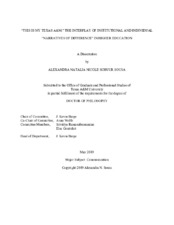| dc.description.abstract | Although most colleges and universities claim to be committed to the values of diversity and inclusion, repeated race-related incidents across the nation highlight the ongoing need to engage issues of race on college campuses. However, it is important to explore these issues at the institutional and individual level. Narratives are an important way to engage this interplay because they serve as tools for both institutional and individual identity negotiation. In particular, I am focused on “narratives of difference,” which I define as those that explore experiences of difference and identity. As such, this study examines how institutional and individual “narratives of difference” interact within institutions of higher education to influence core organizational narratives and students’ relationship to the institution. In order to engage this central problem, I employed three methodologies: (1) archival analysis, (2) photovoice, and (3) walking tour interviews. What I found is that Texas A&M has framed its core institutional narratives, which are grounded in its (military) history, traditions, and core values, to reinforce the notion of the “Aggie Family” as inherently inclusive. The result is the advancement of a model of inclusion as assimilation. As long as newcomers, regardless of their identities, are willing to assimilate into the existing culture, they will be welcomed here. Likewise, the university uses memorialized places and campus tours as occasions for telling this institutional story stock and to reinforce its macro culture. At Texas A&M University, being part of the “Aggie Family” is a unifying force and students across all racial groups take pride in it. However, how exactly the “Aggie Family” is defined is more malleable than the university presents. While the institution has promoted the values of the “Aggie Family” as inherently inclusive, the experiences of diverse students challenge this. They resist full assimilation into this construction by joining identity-based organizations and creating supportive communities with other students from similar backgrounds, highlighting means of improving inclusivity. These findings illuminate meaningful implications for higher education institutions, organizations in general, as well as the field of communication. | en |


